The University of Southern Denmark has campuses located in Southern Denmark and on Zealand. It offers a number of joint programmes in co-operation with the University of Flensburg and the University of Kiel. Contacts with regional industries and the international scientific community are strong.

Jean Pierre Carl Buron, known professionally as Jean Hersholt, was a Danish-American actor. He is most famous for starring on the CBS radio series Dr. Christian from 1937–1954, which later inspired a TV series with the same name from 1956-1957. He also co-starred with Shirley Temple in the film Heidi (1937). When asked how to pronounce his name, he told The Literary Digest, "in English her'sholt; in Danish, hairs'hult." From 1924 to 1955, he had 140 motion picture credits: 75 silent film and 65 "talkies"; he directed four.
The Technical University of Denmark, often simply referred to as DTU, is a polytechnic university and school of engineering. It was founded in 1829 at the initiative of Hans Christian Ørsted as Denmark's first polytechnic, and it is today ranked among Europe's leading engineering institutions. It is located in the town Kongens Lyngby, 12 kilometres (7.5 mi) north of central Copenhagen, Denmark.

Hillerød is a Danish town with a population of 36,227 located in the centre of North Zealand approximately 30 km to the northwest of Copenhagen, Denmark. Hillerød is the administrative centre of Hillerød Municipality and also the administrative seat of Region Hovedstaden, one of the five regions in Denmark. It is most known for its large Renaissance castle, Frederiksborg Castle, now home to the Museum of National History. Hillerød station is the terminus of one of the radials of the S-train network as well as several local railway lines. The town is surrounded by the former royal forests of Gribskov to the north and Store Dyrehave to the south.

Bernstorff Palace in Gentofte, Copenhagen, Denmark, was built in the middle of the 18th century for Foreign Minister Count Johann Hartwig Ernst von Bernstorff. It remained in the possession of the Bernstorff family until 1812. In 1842, it was bought by Christian VIII. For many years, it was used as a summer residence by Christian IX until his death in 1906.
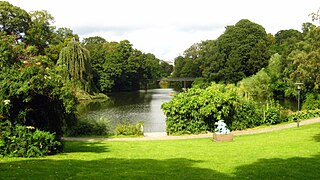
Copenhagen is a green city well endowed with open spaces. It has an extensive and well-distributed system of parks that act as venues for a wide array of events and urban life. As a supplement to the regular parks, there are a number of congenial public gardens and some cemeteries doubling as parks. It is official municipal policy in Copenhagen that all citizens by 2015 must be able to reach a park or beach on foot in less than 15 minutes.
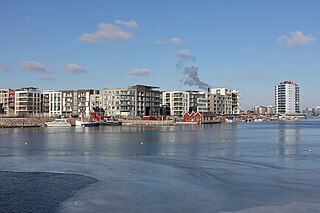
Sluseholmen is an artificial peninsula in the South Harbour of Copenhagen, Denmark. It takes its name from Slusen, a lock immediately to the south, regulating water levels in the harbor. Previously the site of heavy industry and part of the Southern Docklands of Port of Copenhagen, Sluseholmen has, since the turn of the millennium, undergone massive redevelopment, transforming it into a mainly residential district known for its canals and maritime atmosphere. It is connected to Teglholmen by the Teglværk Bridge.

Teglholmen is a peninsula in the South Harbour of Copenhagen, Denmark, located between Sluseholmen and Enghave Brygge. The former dockland area used to house heavy industry. While some industry activities remain in the area, but since most industry left the area, starting in the 1970s, it has undergone massive redevelopment, though some industrial activities remain, most notably MAN B&W Diesel's motor development plant. Today the area houses both a considerable number of Danish and regional headquarters of multinational companies and residential developments. Teglholmen is home to Aalborg University's AAU Cph Campus as well as TV 2's activities in Copenhagen.
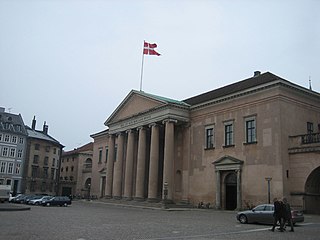
The Copenhagen Court House is a historic building located on Nytorv in Copenhagen, Denmark. Originally built as a combined city hall and courthouse, it now serves as the seat of the District Court of Copenhagen. Inaugurated in 1815, it was built to the design of Christian Frederik Hansen in Neoclassical style.
Fænø is a small Danish island in the Little Belt off the west coast of Funen in Middelfart Municipality. With an area of 3.9 km2, as of 1 January 2010 it has a population of just 2. Reaching a height of 39 metres above sea level at its highest point, the island is privately owned. Fænøgå
DDC-I, Inc. is a privately held company providing software development of real-time operating systems, software development tools, and software services for safety-critical embedded applications, headquartered in Phoenix, Arizona. It was first created in 1985 as the Danish firm DDC International A/S, a commercial outgrowth of Dansk Datamatik Center, a Danish software research and development organization of the 1980s. The American subsidiary was created in 1986. For many years, the firm specialized in language compilers for the programming language Ada.
Danish Architecture Center (DAC) is an international cultural attraction for everyone who wants to explore and understand how architecture and design create the framework for our lives. They believe that architecture can change the world and that it can be part of the solution to future challenges in relation to the UN’s Global Goals.
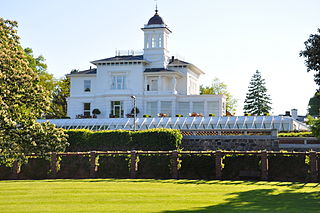
Hvidøre House is a former country house at Klampenborg, just south of Bellevue Beach, on the Øresund coast north of Copenhagen, Denmark. It is most known for serving as the home of Dowager Empress Maria Feodorovna of Russia, daughter of King Christian IX and mother of the last emperor of Russia, Nicholas II, after she was exiled by the Russian Revolution of 1917. It now serves as a conference and training venue for the Novo Group.
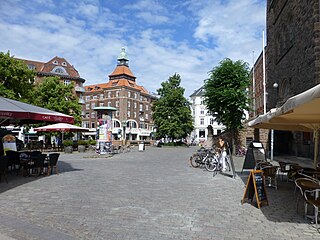
Vesterbros Torv is a public square located at the corner of Vesterbrogade and Gasværksvej in the heart of the Vesterbro district of Copenhagen, Denmark. It is dominated by Elijah's Church.
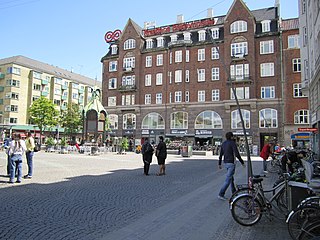
Christianshavns Torv is the central public square of the Christianshavn neighborhood in Copenhagen, Denmark. It is situated at the intersection of Torvegade and Christianshavn Canal, roughly at the center of the area.

The City Campus is one of the University of Copenhagen's four campuses in Copenhagen, Denmark. It is home to the Faculty of Social Sciences and parts of the Faculty of Health and Medical Sciences and the Faculty of Science. The main campus area, the Center for Health and Society, is situated on Øster Farimagsgade, across the street from the University's Botanical Garden, which is also part of the campus area. The City Campus also comprises a building on Øster Voldgade and the university headquarters on Frue Plads.

The Google Maps pin is the inverted-drop-shaped icon that marks locations in Google Maps. The pin is protected under a U.S. design patent as "teardrop-shaped marker icon including a shadow". Google has used the pin in various graphics, games, and promotional materials.
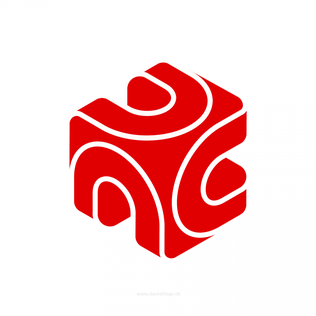
Dansk Datamatik Center (DDC) was a Danish software research and development centre that existed from 1979 to 1989. Its main purpose was to demonstrate the value of using modern techniques, especially those involving formal methods, in software design and development.

Rosenørns Allé is a street located on the border between Frederiksberg and Nørrebro, on the west side of The Lakes, in Copenhagen, Denmark. The street branches from the south side of the busy thoroughfare Kampmannsgade-Åboulevard at the west end of the embankment which separates St. Jørgen's Lake from Peblinge Lake, runs west to Julius Thomsens Plads and then continues in a more northwesterly direction to Bülowsvej where it turns into Rolighedsvej and later Godthåbsvej before reaching Bellahøj in Brønshøj.

Nyelandsvej is a street in the Frederiksberg district of Copenhagen, Denmark. It runs from Falkoner Allé in the southeast to a roundabout at the north end of Dalgas Boulevard in the northwest. The more urban, eastern part of the street, between Falkoner Allé and Nordre Fasanvej, separates an area with Copenhagen Business School's Solbjerg Campus and Frederiksberg Centret to the south from the Svømmehal Quarter to the north. The western part of the street is passes the multi-purpose venue Keddelhallen and Frederiksberg Hospital before entering an area with Single-family detached homes.















